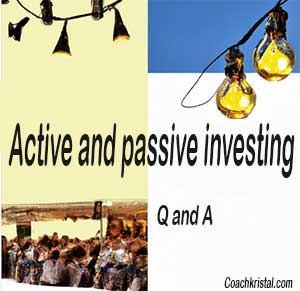
As an investor, one of the key factors to consider is decisions you will make is deciding between active and passive investing. Both methods have pros and cons, and it’s essential to understand them before choosing a strategy. In this blog post, we’ll take a deep dive into active and passive investing, exploring the key differences between the two approaches, their respective benefits, and the best way to decide which one is right for you.

What is Active Investing?
Active investing is a strategy where investors attempt to outperform the market by selecting individual stocks, timing the market, and making frequent trades. The idea behind active investing is that through careful research, analysis, and market timing, investors can generate returns that are greater than the market average.

What is Passive Investing?
Passive investing, on the other hand, is a strategy where investors seek to match the performance of a market index by investing in a portfolio of stocks or other assets that mirror the index. The goal of passive investing is to achieve average market returns, which are generally more predictable and less volatile than the returns generated by active investing.
What Are The Pros and Cons of Active Investing?
Active investing can potentially generate higher returns than passive investing, but it requires a great deal of time, research, and skill. Additionally, active investing can be costly, as frequent trades and high fees can eat into profits. Finally, it’s challenging to outperform the market consistently, and many active investors fail to do so over the long term.
Pros and Cons of Passive Investing
Passive investing is a low-cost, low-maintenance investment strategy that can provide reliable returns over the long term. However, passive investors will never outperform the market, and their returns will always be average. Additionally, because passive investing usually involves investing in a basket of stocks or other assets that mirror the market, investors are vulnerable to downturns and volatility.
Both have strengths, both have flaws, It’s up to you to pick the cause.
If you made 4% per week, how long would it take to double your money? How? https://wealth.coachkristal.com
How to Decide Between Active and Passive Investing
Investing actively or passively depends on your financial goals, investment experience, and risk tolerance. If you’re looking for potentially higher returns and willing to put in the extra time required to research and analyze individual stocks, active investing may be the right choice. If you prefer a low-maintenance approach and are comfortable with average market returns, passive investing may be the better option.
Conclusion Active And Passive Investing
Active And Passive Investing
In conclusion, both active and passive investments have their strengths and weaknesses, and it’s important to consider various investment strategies before deciding where to invest your money. As an informed investor, you must understand the risks associated with each approach, and the potential returns and costs involved.
Active investors tend to rely on investment managers to research and analyze individual assets, time the markets, and make frequent trades. Passive investors, on the other hand, opt for passive investment strategies that aim to match the performance of the markets, investing in funds that track market indices.
Individual investors, professional investors, and asset managers can all invest actively or passively, depending on their investment goals and risk tolerance. Passive investments offer low-cost, low-maintenance options, whereas active Investing carries the potential for higher returns, but come with higher costs and risks.
Choosing between active and passive investing ultimately depends on your individual financial goals. and financial situation. By evaluating your investment objectives and understanding the benefits and risks associated with each approach, you can choose a strategy that suits your needs and helps you achieve your investment goals.

Active And Passive Investing Q and A
Q: Is active or passive investing better?
A: There is no one-size-fits-all answer to the question of whether active or passive investing is better. Both approaches have their strengths and weaknesses, and the choice between them ultimately depends on an investor’s personal investment goals, risk tolerance, and financial situation.
Q: What is the best passive income investment?
A: The best passive income investments vary based on financial goals, risk tolerance, and investment horizon. Popular options include rental real estate, dividend-paying stocks, ETFs, and REITs. These investments offer rental income, regular payments, diversification, and potential growth. Investors should evaluate each option and seek professional advice to align with their financial objectives.
Q: Are blockchains good passive income investments?
A: Blockchain investments involve blockchain technology and cryptocurrency assets. Blockchain is a decentralized ledger that enables secure and transparent transactions without central authority. Cryptocurrencies like Bitcoin and Ethereum use blockchain for transactions. Investors can access blockchain and cryptocurrency via ETFs, publicly-traded companies, and direct investments. However, these investments are highly volatile with security and regulatory risks. Investors should weigh risks, rewards, financial goals, and risk tolerance before investing. Example: Earn 4% weekly passive rewords and learn how to to mirror trade here: Passive Income